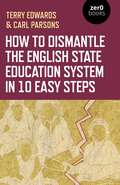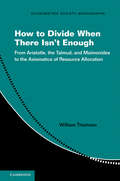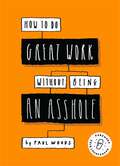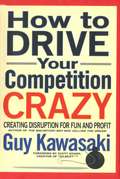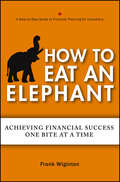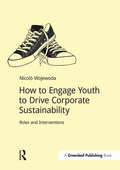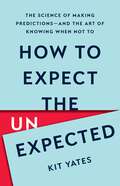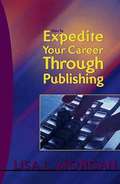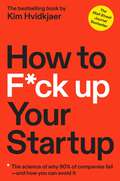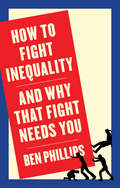- Table View
- List View
How to Dismantle the English State Education System in 10 Easy Steps: The Academy Experiment
by Terry Edwards Carl Parsons'A sharp and incisive account of how state education has been dismantled into a system of competing Multi-Academy Trusts. We were told &‘choice' would deliver higher standards. It didn't. It made the system more chaotic, wasteful and segregated. This book explains how it was done.' Alasdair Smith, National Secretary, Anti Academies AllianceTerry Edwards and Carl Parsons tell the story of the takeover of England's schools by the super-efficient, modernising, academising machine, which, in collaboration with a dynamic, forward-looking government is recasting the educational landscape. England's school system is turbo-charged into a new era and will be the envy of the world, led by Chief Executives of Multi Academy Trusts on bankers' salaries, imposing a slim curriculum, the soundest of discipline regimes and ensuring that highest standards will be achieved even if at the expense of teacher morale, poor service to special needs, off-rolling of students and despite an absolute lack of evidence that this privatised system works.
How to Dismantle the NHS in 10 Easy Steps
by Youssef El-GingihyDr Youssef El-Gingihy – a GP – tells the story of how the NHS has been gradually converted into a market-based healthcare system over the past 25 years. This process is accelerating under the Coalition government and the very existence of a National Health Service is in danger. He fears that there will not be an NHS as our generation grows old and certainly not for our children. Yet the British public remains largely unawares of this and the media, with few exceptions, have failed in their duty to inform them. The NHS is being broken up into an universal insurance system based on the American model. This book matters to all who use the NHS or are concerned by the privatisation of public services and the dismantling of equitable healthcare and welfare. If you want to understand the real story behind the headlines and find out how you can preserve the NHS for the future then this book is essential reading.
How to Dismantle the NHS in 10 Easy Steps: The Blueprint That The Government Does Not Want You To See
by Youssef El-GingihyEvents have spiralled since the first edition of How to Dismantle the NHS in 10 Easy Steps. The junior doctors' strike, the Conservative victory in the 2015 general election, the Corbyn phenomenon, the unexpected Brexit vote and the arguably even more unexpected loss of the Conservative majority in 2017. Further, since writing the first edition, Dr. Youssef El-Gingihy found himself stricken with a life-threatening illness and the NHS doctor became the NHS patient. The fight to save the NHS transformed into a fight for his own life. Now, fully recovered, Dr. Youssef El-Gingihy returns to his 10 Easy Steps in order to strengthen his original argument and continue what Labour leader, Jeremy Corbyn, deems 'one of the most fundamental battles we face in a struggle for a British society that works for the many'. In the year of the 70th anniversary of the NHS, Dr El-Gingihy's insights have never been more vital as our national health service continues to be hit by the privatisation of public services. New expanded second edition with chapters on junior doctor's strikes and plans for US-style healthcare.
How to Divide When There Isn't Enough: From Aristotle, the Talmud, and Maimonides to the Axiomatics of Resource Allocation (Econometric Society Monographs #62)
by William ThomsonHow to Divide When There Isn't Enough develops a rigorous yet accessible presentation of the state-of-the-art for the adjudication of conflicting claims and the theory of taxation. It covers all aspects one may wish to know about claims problems: the most important rules, the most important axioms, and how these two sets are related. More generally, it also serves as an introduction to the modern theory of economic design, which in the last twenty years has revolutionized many areas of economics, generating a wide range of applicable allocations rules that have improved people's lives in many ways. In developing the theory, the book employs a variety of techniques that will appeal to both experts and non-experts. Compiling decades of research into a single framework, William Thomson provides numerous applications that will open a large number of avenues for future research.
How to Do Great Work Without Being an Asshole: (guides For Creative Industries)
by Paul Woods'How to Do Great Work Without Being an Asshole, a new book by designer Paul Woods, is a practical, illustrated guide that does exactly what the title suggests: It shows you how to be both creative and act like a grown-up at work.' - Fast CompanyIt's long been an accepted, almost celebrated, fact of the creative industries that long hours, chaotic workflows and egotistical colleagues are just the price you pay to produce great work. In fact, this toxic culture is the enemy of creativity, and with greater accountability and transparency in the industry - and more choice for young talent - than ever before, this unsustainable way of doing business is a ticking time bomb.This is a straight-talking, fun read for all creatives: Director or junior, at an agency or client-side, working in design, advertising, publishing, fashion or film.Packed with anecdotes, self-analysis flowcharts (are YOU the asshole?!), humorous graphics, and helpful exercises and action plans for better working practices.Simple strategies can easily be implemented to create a happier, more productive team and - importantly - BETTER WORK!Read this guide to develop the ultimate creative process and bring your productivity and teamwork to a new level.How to Do Great Work Without Being an Asshole addresses hot topics like:Building a better office cultureDealing with egosMeeting etiquetteBest practices for pitching and scopingMaking the most of creative briefingsHow to give constructive, clear feedbackGiving better presentations How to approach workloads and long hoursGuidelines for good client relationshipsHiring and being hiredFiring and being firedAnd much more!
How to Do Great Work Without Being an Asshole: (guides For Creative Industries)
by Paul Woods'How to Do Great Work Without Being an Asshole, a new book by designer Paul Woods, is a practical, illustrated guide that does exactly what the title suggests: It shows you how to be both creative and act like a grown-up at work.' - Fast CompanyIt's long been an accepted, almost celebrated, fact of the creative industries that long hours, chaotic workflows and egotistical colleagues are just the price you pay to produce great work. In fact, this toxic culture is the enemy of creativity, and with greater accountability and transparency in the industry - and more choice for young talent - than ever before, this unsustainable way of doing business is a ticking time bomb.This is a straight-talking, fun read for all creatives: Director or junior, at an agency or client-side, working in design, advertising, publishing, fashion or film.Packed with anecdotes, self-analysis flowcharts (are YOU the asshole?!), humorous graphics, and helpful exercises and action plans for better working practices.Simple strategies can easily be implemented to create a happier, more productive team and - importantly - BETTER WORK!Read this guide to develop the ultimate creative process and bring your productivity and teamwork to a new level.How to Do Great Work Without Being an Asshole addresses hot topics like:Building a better office cultureDealing with egosMeeting etiquetteBest practices for pitching and scopingMaking the most of creative briefingsHow to give constructive, clear feedbackGiving better presentations How to approach workloads and long hoursGuidelines for good client relationshipsHiring and being hiredFiring and being firedAnd much more!
How to Drive Your Competition Crazy: Creating Disruption for Fun and Profit
by Guy KawasakiA rogue business strategist and marketing expert offers irreverent, unconventional, and extreme strategies in sales, marketing, production, and human resources to crush the competition. If you were intrigued by the title of this book, you are probably the type of business book reader who's had enough of management self-help and touchy-feely tomes, enough of how-to guides that encourage you to take the kinder, gentler approach to competitors, customers, and employees. You are ready for the gloves to come off, and the one thing you'll want in your hands when they do is the first can-do, how-to, kick-butt gonzo guide to driving your competitors off the deep end. In the time-honored tradition of the maxim "It's not how you play the game, but whether you win or lose," Forbes columnist and bestselling author of Selling the Dream Guy Kawasaki has written the definitive take-no-prisoners guide to help the Davids beat the Goliaths. The product of Kawasaki's years of experience as an evangelist for the then-upstart Apple and as a computer guru and business strategist, How to Drive Your Competition Crazy is an invaluable source book of irreverent and sometimes extreme stratagems in sales, marketing, production, and human resources that will help your company or organization get and keep the upper hand. Whether you are launching a new company or product, consolidating your strength in the marketplace, or trying to hold your own against a competitor with greater resources, How to Drive Your Competition Crazy offers a comprehensive blueprint for success. From the initial steps of learning as much about your own company as you do about your enemy to advanced techniques like playing with your opponents' minds, Guy Kawasaki explores every facet of the premise that the best defense is a good offense. Staking territory somewhere between the arts of Zen and war, How to Drive Your Competition Crazy is a resource no company can afford to be without.
How to Eat an Elephant
by Frank WigintonTake control of your personal finances--one bite at a timeGetting your financial house in order is a big job. At first, you might even feel like you've bitten off more than you can chew. But don't give up! In How to Eat an Elephant, you'll gain vital understanding of important personal finance basics in just one day a month. Rather than tackle the beast in one bite, you'll master it a little bit at a time. Supported by online resources, tools, and reports, you'll complete fundamental tasks and gain fundamental understanding in an orderly and effective way.With practical, easy-to-understand guidance, this book will show you how to reduce your debt and save on interest; improve your understanding of personal finance basics and gain new confidence; reduce stress and anxiety about your money; and use powerful online tools to organize all your financial information.Offers a structured, non-intimidating approach to personal finance that can be mastered in four hours a monthCovers vital topics like budgeting, life insurance, investment products, retirement planning, wills and powers of attorney, and much moreWritten by Frank Wiginton, one of Canada's best-known personal finance speakers and gurusIf it's time to take charge of your financial life, look no further. How to Eat an Elephant offers real solutions that will save you time, money, and headaches.
How to Encourage Others to Give and When to Pass the Torch? Insights from The Philanthropy Connection
by Kathleen L. McGinn Christine L. ExleyThis case follows the co-founder and president, Marla Felcher, of The Philanthropy Connection (TPC). TPC is a nonprofit organization that centers around collective giving: members of TPC make an annual contribution that is then distributed to select nonprofit organizations via grants. As Felcher works to maximize how much money they can give out via grants, this case allows for a deep dive into the motives for giving and how the organizational structure and processes can tap into why people give. As this case begins with Felcher's founding of TPC and concludes with Felcher desiring to step down from her role as president, this case also allows for a rich discussion around if and when a nonprofit founder should step aside to let the next round of leaders takeover.
How to Engage Youth to Drive Corporate Sustainability: Roles and Interventions
by Nicolò WojewodaHow to Engage Youth to Drive Corporate Sustainability provides practical, specific recommendations that professionals can adopt to improve engagement of young people and drive forward corporate sustainability efforts.
How to Engage with the Private Sector in Public-Private Partnerships in Emerging Markets
by E. R. Yescombe Edward Farquharson Javier Encinas Clemencia Torres de MästleThere is increasing interest in the use of public-private partnerships in emerging markets. But what does this actually require governments to do if they are to establish successful long term partnerships with private partners and ensure that public partner has the right information, on the right projects, for the right partners at the right time.? This book takes the reader through the steps in the life of a PPP to provide a realistic overview of what is required successfully to engage and manage such a partnership from the early stages. Drawing on experience from both mature and developing PPP markets across the world, the book assesses the policies, processes and institutions that are needed to select the right projects and manage the preparation of projects for market and their subsequent operation. It also looks at the role of advisers, and how they should be selected and used. Particularly in light of the recent financial crisis, the various approaches used to finance projects are also considered together with the policy responses that governments have recently adopted. Case studies are used to illustrate the key messages throughout. The book recognizes that governments will use a wide range of PPPs in different sectors and that legal and administrative systems vary. The purpose of the book is to identify and bringing clarity to the underlying principles so that there is a better understanding of why and how the various processes are carried out. This book is aimed primarily at public officials who are involved with delivery of infrastructure projects and services through partnership with the private sector as well as institutions who are looking to support PPP programmes.
How to Engage, Involve, and Motivate Employees: Building a Culture of Lean Leadership and Two-Way Communication
by Michael McCarthy Janis AllenThis book, which takes the employees' perspective, illustrates what works and what doesn't work to engage, involve, and motivate a workforce. Through examples, it shows how the "engage" methodology links to the Lean Process. While focusing on the softer/"people" part of Lean, it maximizes the value returned on the organization's investment in Lean. It links "engagement" to measurable performance improvements. The how-to book includes a methodology overview and details on how to implement including communication do's and don'ts as well as a checklist for leader standard work (a tool for individual leaders to track and be recognized for their "engage, involve, and motivate" behaviors).
How to Escape Lifetime Security and Pursue Your Impossible Dream: A Guide to Transforming Your Career
by Kenneth AtchityFor the Type C, or creative, personalities who want their work to "fill" their deepest creative urges, this is the frontline guide to making the transition from a secure and soulless job to a life built around a creative dream. Individuals learn how to follow the mind's eye to construct a life that conforms to personal vision, steal time to make creative dreams come true, use as assets the resources around them, and turn creative goals and objectives into an effective life plan. Introduces the catchy buzzword "Type C"Allworth Press, an imprint of Skyhorse Publishing, publishes a broad range of books on the visual and performing arts, with emphasis on the business of art. Our titles cover subjects such as graphic design, theater, branding, fine art, photography, interior design, writing, acting, film, how to start careers, business and legal forms, business practices, and more. While we don't aspire to publish a New York Times bestseller or a national bestseller, we are deeply committed to quality books that help creative professionals succeed and thrive. We often publish in areas overlooked by other publishers and welcome the author whose expertise can help our audience of readers.
How to Expect the Unexpected: The Science of Making Predictions—and the Art of Knowing When Not To
by Kit YatesA &“vivid, wide-ranging, and delightful guide&” (bestselling author Tim Harford) for understanding how and why predictions go wrong, with practical tips to give you a better chance of getting them right How can you be 100 percent sure you will win a bet? Why did so many Pompeians stay put while Mount Vesuvius was erupting? Are you more likely to work in a kitchen if your last name is Baker? Ever since the dawn of human civilization, we have been trying to make predictions about what the world has in store for us. For just as long, we have been getting it wrong. In How to Expect the Unexpected, mathematician Kit Yates uncovers the surprising science that undergirds our predictions—and how we can use it to our advantage. From religious oracles to weather forecasters, and from politicians to economists, we are subjected to poor predictions all the time. Synthesizing results from math, biology, psychology, sociology, medicine, economic theory, and physics, Yates provides tools for readers to understand uncertainty and to recognize the cognitive biases that make accurate predictions so hard to come by. This book will teach you how and why predictions go wrong, help you to spot phony forecasts, and give you a better chance of getting your own predictions correct.
How to Expedite Your Career Through Publishing
by Lisa L. MorganThere are a lot of books dedicated to career building and a lot of books dedicated to writing. Some will teach you how to write better resumes, business letters, or business plans. Yet, none really focus on how to build a career through publishing. That's what this book is all about. Clear examples; lots of resources.
How to F*ck Up Your Startup: The Science Behind Why 90% of Companies Fail--and How You Can Avoid It
by Kim HvidkjaerWALL STREET JOURNAL BESTSELLER Every business owner dreams of success, but the majority of businesses are doomed to fail. This book offers a journey through the pitfalls that cause 90% of companies to crash—and the crucial remedies entrepreneurs can use to avoid (or fix) them. Kim Hvidkjær was 29 years old when he became a millionaire. Two years later, after a cluster of disasters, he found himself basically broke. Now, having rebuilt his fortune as the founder of several successful enterprises and studied thousands of failed startups, Hvidkjær has become an expert in failure: what it means, what it looks like, and the strategies that business owners can use to prevent it. In How to F*ck Up Your Startup, he takes us on an entertaining and enlightening journey through the complex patterns of failure in the life cycle of a business, covering: Attitude mistakes Business model missteps Market research snafus Funding and financial blunders Product development errors Organization oversights Sales slip-ups Growing pains Most important, he tackles what to do when your business has gone wrong. Hvidkjær fleshes out a tangible, usable blueprint for entrepreneurs looking to learn (the easy way) from the mistakes of businesses gone before. Chock-full of easy-to-follow business lessons that will keep you from f*cking up your startup, this down-to-earth guide offers crucial, actionable advice for seasoned business owners and startup founders alike. A masterclass in failure, How to F*ck Up Your Startup is required reading for reaching success.
How to Fail at Almost Everything and Still Win Big
by Scott AdamsScott Adams has likely failed at more things than anyone you've ever met or anyone you've even heard of. So how did he go from hapless office worker and serial failure to the creator of Dilbert, one of the world's most famous syndicated comic strips, in just a few years? In How to Fail at Almost Everything and Still Win Big, Adams shares the strategy he has used since he was a teen to invite failure in, to embrace it, then pick its pocket. No career guide can offer advice for success that works for everyone. As Adams explains, your best bet is to study the ways of others who made it big and try to glean some tricks and strategies that make sense for you. Adams pulls back the covers on his own unusual life and shares what he learned for turning one failure after another into something good and lasting. Adams reveals that he failed at just about everything he's tried, including his corporate career, his inventions, his investments, and his two restaurants. But there's a lot to learn from his personal story, and a lot of humor along the way. While it's hard for anyone to recover from a personal or professional failure, Adams discovered some unlikely truths that helped to propel him forward. For instance:* Goals are for losers. Systems are for winners. * "Passion" is bull. What you need is personal energy. * A combination of mediocre skills can make you surprisingly valuable. * You can manage your odds in a way that makes you look lucky to others. You won't find a road map to success in this audiobook. But Adams hopes you can laugh at his failures while discovering some unique and helpful ideas on your own path to personal victory. As he writes: "This is a story of one person's unlikely success within the context of scores of embarrassing failures. Was my eventual success primarily a result of talent, luck, hard work, or an accidental just-right balance of each? All I know for sure is that I pursued a conscious strategy of managing my opportunities in a way that would make it easier for luck to find me. "
How to Fail at Almost Everything and Still Win Big: Kind of the Story of My Life
by Scott AdamsBlasting clichéd career advice, the contrarian pundit and creator of Dilbert recounts the humorous ups and downs of his career, revealing the outsized role of luck in our lives and how best to play the system. Scott Adams has likely failed at more things than anyone you’ve ever met or anyone you’ve even heard of. So how did he go from hapless office worker and serial failure to the creator of Dilbert, one of the world’s most famous syndicated comic strips, in just a few years? In How to Fail at Almost Everything and Still Win Big, Adams shares the game plan he’s followed since he was a teen: invite failure in, embrace it, then pick its pocket. No career guide can offer advice that works for everyone. As Adams explains, your best bet is to study the ways of others who made it big and try to glean some tricks and strategies that make sense for you. Adams pulls back the covers on his own unusual life and shares how he turned one failure after another—including his corporate career, his inventions, his investments, and his two restaurants—into something good and lasting. There’s a lot to learn from his personal story, and a lot of entertainment along the way. Adams discovered some unlikely truths that helped to propel him forward. For instance: • Goals are for losers. Systems are for winners. • “Passion” is bull. What you need is personal energy. • A combination of mediocre skills can make you surprisingly valuable. • You can manage your odds in a way that makes you look lucky to others. Adams hopes you can laugh at his failures while discovering some unique and helpful ideas on your own path to personal victory. As he writes: “This is a story of one person’s unlikely success within the context of scores of embarrassing failures. Was my eventual success primarily a result of talent, luck, hard work, or an accidental just-right balance of each? All I know for sure is that I pursued a conscious strategy of managing my opportunities in a way that would make it easier for luck to find me.”
How to Feed Your Whole Family a Healthy, Balanced Diet with Very Little Money: and hardly any time, even if you have a tiny kitchen, only three saucepans (one with an ill-fitting lid) and no fancy gadgets - unless you count the garlic crusher… Simple, wholesome and nutritious recipes for family meals
by Gill HolcombeThis book provides simple, wholesome and nutritious recipes for family meals; quick lunches, tasty puddings and cakes and you don t have to spend hours slaving over a hot stove, or spend a fortune at the supermarket. There are menu plans, recipes, shortcuts and dozens of ideas for every meal, together with tried and tested tips to help you save your valuable time and money.
How to Feed Your Whole Family a Healthy, Balanced Diet with Very Little Money: and hardly any time, even if you have a tiny kitchen, only three saucepans (one with an ill-fitting lid) and no fancy gadgets - unless you count the garlic crusher… Simple, wholesome and nutritious recipes for family meals
by Gill HolcombeThis book provides simple, wholesome and nutritious recipes for family meals; quick lunches, tasty puddings and cakes and you don t have to spend hours slaving over a hot stove, or spend a fortune at the supermarket. There are menu plans, recipes, shortcuts and dozens of ideas for every meal, together with tried and tested tips to help you save your valuable time and money.
How to Feed the World
by Jessica Eise Dr Ken FosterBy 2050, we will have ten billion mouths to feed in a world profoundly altered by environmental change. How can we meet this challenge? In How to Feed the World, a diverse group of experts from Purdue University break down this crucial question by tackling big issues one-by-one. Covering population, water, land, climate change, technology, food systems, trade, food waste and loss, health, social buy-in, communication, and, lastly, the ultimate challenge of achieving equal access to food, the book reveals a complex web of factors that must be addressed in order to reach global food security.How to Feed the World unites contributors from different perspectives and academic disciplines, ranging from agronomyand hydrology to agricultural economy and communication. Hailing from Germany, the Philippines, the U.S., Ecuador, and beyond, the contributors weave their own life experiences into their chapters, connecting global issues to our tangible, day-to-day existence. Across every chapter, a similar theme emerges: these are not simple problems, yet we canovercome them. Doing so will require cooperation between farmers, scientists, policy makers, consumers, andmany others.The resulting collection is an accessible but wide-ranging look at the modern food system. Readers will not only get asolid grounding in key issues, but be challenged to investigate further and contribute to the paramount effort to feed theworld.
How to Fight Inequality: And Why That Fight Needs You
by Ben PhillipsInequality is the crisis of our time. The growing gap between a few at the top and the rest of society damages us all. No longer able to deny the crisis, every government in the world is now pledged to fix it – and yet it keeps on getting worse. In this book, international anti-inequality campaigner Ben Phillips shows why winning the debate is not enough: we have to win the fight. Drawing on his insider experience, and his personal exchanges with the real-life heroes of successful movements, he shows how the battle against inequality has been won before, and he shares a practical plan for defeating inequality again. He sets a route map for us to overcome deference, build our collective power, and create a new story. Most books on inequality are about what other people ought to do about it – this book is about why winning the fight needs you. Tired of feeling helpless in the face of spiralling inequality? Want to know what you can do about it? This is the book for you.
How to Figure Out What to Do with Your Life (Next)
by Jennifer Turliuk“An amazing and brilliant instruction manual on how to find purpose, build a career, and live a life of fulfillment.” – DEEPAK CHOPRA A surefire guide to planning your next career move and discovering the job you really want.Jennifer Turliuk was dissatisfied in her corporate job, so she quit. But she had no idea what to do next. After university, she, like so many graduates, focused on just getting a job rather than figuring out the career she really wanted. Instead of getting another degree or going back to school to change her career path, Turliuk embarked on a “self-education journey,” interviewing and shadowing some of the world’s leading professors, founders, and investors from Silicon Valley companies such as Airbnb, Square, and Kiva. What she discovered was not only a way to find out what she really wanted to do with her own life, but also a career-design process that would help others do just the same. Turliuk’s career-prototyping framework uses tested strategies and exercises, including quantified self, design thinking, and lean methodology to help everyone from recent graduates to mid-career workers looking for a change. Let this book be your guide to finding a satisfying and passion-driven career that is right for you.
How to File for Chapter 7 Bankruptcy
by Stephen Elias Albin Renauer Cara O'NeillIf you have more debt than you can possibly pay off, the bankruptcy system is there to help -- and with How to File for Chapter 7 Bankruptcy, you'll find the clear and user-friendly information, advice, and step-by-step instructions youâ TMll need to get through the entire process. First, the book will help you determine whether you qualify for Chapter 7 -- and whether it is the best way to deal with your debts. Then you'll find out how to: stop wage garnishments and attachments cancel as much debt as possible deal with secured debts keep the maximum amount of property keep your home, if possible ebuild credit after bankruptcy The 19th edition is revised to include instructions on filling out the new means test forms, changes to state exemption laws (that determine what property bankruptcy filers may keep), and the latest court decisions. Plus, state and federal charts let you quickly find your state's exemption laws. Please note: This book does not cover business bankruptcies, farm reorganizations, or individual repayment plans (Chapter 13). For Chapter 13 bankruptcy, see Nolo's Chapter 13 Bankruptcy.
How to File for Chapter 7 Bankruptcy
by Stephen Elias Albin Renauer Cara O'NeillIf you’re overwhelmed by debt, the bankruptcy system can help. How to File for Chapter 7 Bankruptcy provides the clear information and step-by-step instructions you’ll need to get through the entire process without an attorney. The book will help you determine whether you qualify for relief and whether filing for Chapter 7 bankruptcy will help you solve your debt issues. You’ll also learn how to: stop wage garnishments and lawsuits wipe out as much debt as possible deal with debts you’ve secured with collateral keep as much property as possible, and rebuild credit after bankruptcy The 20th edition is revised to include instructions that will help you complete the new user-friendly bankruptcy forms, changes to state exemption laws (which determine what property bankruptcy filers can keep), and important legal updates. Please note: This book does not cover business bankruptcies, farm reorganizations, or individual repayment plans (Chapter 13). For Chapter 13 bankruptcy, see Nolo's Chapter 13 Bankruptcy.
